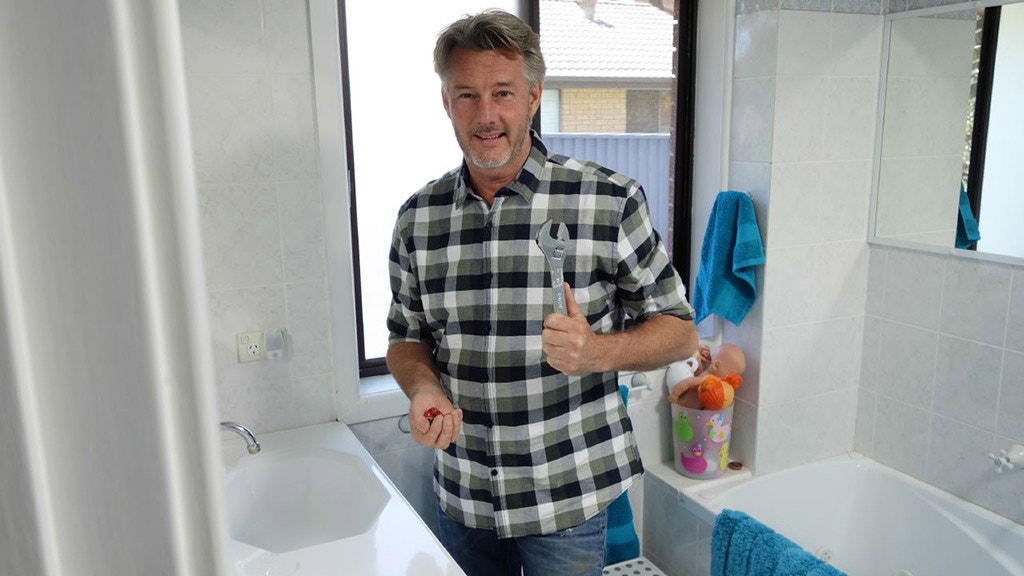Tip 1 - Checking For A Leaking Tap
Barry understands the importance of fixing any dripping taps or leaky toilets. A leaking tap can waste as much as 20,000 litres of water a year, which could cost you up to $1,400!
1. To check for leaks, read your water meter before and after a two-hour period when no water is being used. If the meter does not read exactly the same, you’ve got a leak!
2. Before getting started, make sure you turn off your water supply at the mains. If you live in a house, your water main will be out on the street or in the front yard. If you live in a flat or townhouse, the mains tap will probably be inside the bathroom or laundry.
3. Turn on the tap to release any water left in the pipe, then put a plug in the basin to stop any parts falling down the drain as you work.
4. Using a spanner, take off the tap’s cover to remove the handle. You’ll probably find this under the hot or cold sign.
5. Undo the screw and remove the handle. If the tap has a metal cover, unscrew it by hand, or use a wrench or tap spanner.
6. Unscrew the tap bonnet, and completely remove the headgear. You should see a large body washer, o-ring and jumper valve. The jumper valve should fall out.
7. Replace the body washer, the o-ring and the jumper valve with new parts. Apply a tap lubricant to the spindle and valve for better sealing and smoother tap operation.
8. Refit the bonnet and spindle. Be careful not to over-tighten the nuts.
9. Put the tap back together, turn it off, and turn the water main back on. Now check the tap to make sure it’s no longer leaking.
Tip 2 – Save Water As It Heats Up
One of the most common ways water gets wasted is to leave the shower running while you wait for it to heat up. Rather than waste it, simply use a jug or bucket to collect the water that is currently going down the drain while waiting for it to heat up.
By the time the water is hot in the pipes, you’ll have a bucket of water and a steaming hot shower ready to go. Pour the water onto plants or you can even use it as an alternative to flushing the toilet!
Tip 3 – Replacing A Cistern With A Plastic Bottle
Did you know that older-style toilets use around 18 litres of water per flush? Whereas the latest ultra-low-flush toilets can use as little as 4.5 litres for a full flush and 3 litres for a half flush. A family of 4 (using an older-style toilet) averaging 4 flushes per person, will flush 16 times a day. That is 288 litres of water every day!
Barry shows us how to easily save some water by adding a plastic bottle into the cistern so it uses less water. Here are the steps:
1. Use a narrow plastic bottle; the largest one you can fit in without interfering with the moving parts inside the toilet
2. Place a few heavy items inside the bottle, pebbles or rocks work well, and fill the rest of the bottle up with water. The added weight will help keep it from shifting around when the toilet flushes.
3. Take the lid off the toilet tank and place the canister inside, in an out-of-the-way spot. And that’s it!
Tip 4 – Rain Water Tank
Rainwater collected from a well-designed, well-maintained system can be suitable for all domestic uses. The more uses, the greater the savings in mains water. A small water tank can be plumbed into your toilet and washing machine to save you up to $1400 a year.
Tip 5 – Outdoor Tips
Around 40% of our water usage is outdoors watering our lawns and gardens and even hosing down the paths. When it comes to some tips these are pretty simple.
1. Use a broom or a blower to keep paths and patios clean and avoid using your hose to wash them down.
2. Native plants require less water than introduced species, so go native where possible.
3. Mulch the garden. After the water drains into the soil a layer of mulch protects that water being evaporated straight back up, retaining moisture in the soil for longer.

































